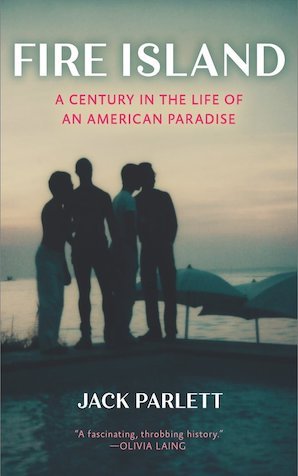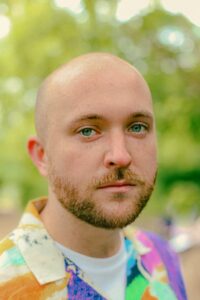Fire Island …the name of the legendary queer nirvana is so evocative. This narrow sand bar off the coast of Long Island, NY, has been synonymous with hedonism for generations of queers. Writer Jack Parlett’s brilliant new book takes us on a beautifully literary journey through the history of this unique place. His book is sophisticated and thought-provoking, with an emphasis on the historical literary representation of queer Fire Island, and its famous visitors. Parlett also doesn’t shy away from highlighting the historic racism, lack of diversity and body positivity associated with the queer scene on the island – issues reflecting American society in general.
…the name of the legendary queer nirvana is so evocative. This narrow sand bar off the coast of Long Island, NY, has been synonymous with hedonism for generations of queers. Writer Jack Parlett’s brilliant new book takes us on a beautifully literary journey through the history of this unique place. His book is sophisticated and thought-provoking, with an emphasis on the historical literary representation of queer Fire Island, and its famous visitors. Parlett also doesn’t shy away from highlighting the historic racism, lack of diversity and body positivity associated with the queer scene on the island – issues reflecting American society in general.
Fire Island started to be a summer destination for New Yorkers in the mid-nineteenth century. Walt Whitman waxed lyrical about it and Oscar Wilde reportedly visited in 1882. It wasn’t until the 1930s, however, that it became popular when groups of bohemians and theatricals from NYC started visiting, seeking respite from the fierce NY summer heat. Both Fire Island Pines and Cherry Grove were the favored destinations for these people, compared to the more family-focused other settlements on the island. A huge hurricane in 1938 wiped out most of Cherry Grove, leading to a fall in rent and land prices. At that point, you could buy a vacant lot for as little as $50. Families left the area, put off by the hurricane and the devastation, and the queers from NY’s established communities around Greenwich Village, Times Square, and Harlem snapped up cheap properties.
The period from 1939 to 1969 attracted queer poets, writers, actors, and theatricals, keen to live a life away from society’s gaze, especially that of the harassing NYPD. People including Truman Capote, Donald Windham, James Baldwin, Tennessee Williams, Tallulah Bankhead, Christopher Isherwood, Carson McCullers and W.H. Auden spent time on the island. Fire Island Boulevard was built in the 1950s, as was the harbor and this led to more monied people visiting the island.
The period post the 1969 Stonewall Riots led to increased confidence in the queer community and more people came out of the closet. The halcyon 1970’s on the island were influenced by disco and the quest for a perfect body, drug-fuelled sexual debauchery, and naked beach life. Regular visitors during this period included Edmund White, Derek Jarman, Andre Leon Talley, Manolo Blahnik, Calvin Klein, David Hockney and Robert Mapplethorpe. The cooler people amongst this crowd were dismissive of the focus on body perfection but even they couldn’t resist the sexual shenanigans in the ‘Meat Rack’ the famous wooded area between the Pines and Cherry Grove. This was the golden age of sex and disco, with the dance floors at The Ice Palace in Cherry Grove and Botel and The Sandpiper in the Pines regularly packed full of shirtless buff men. By its peak in 1979, Fire Island was completely different from how it had been pre-Stonewall in 1969, just 10 years earlier.
The party ended in 1981, however, when the first cases of AIDS reared their head. So many of the key players on the island got sick, died, or just stopped coming. Tourism dropped and the island lost some of its identity, although sex, dancing, and other rituals continued, albeit in a safer, more controlled manner. The need for escapism meant that there was still an intensity to the nightlife. Activists such as Larry Kramer and Vito Russo helped raise awareness of the risks around AIDS, although islanders were not always receptive to real-life news interrupting the island’s perception of utopia. The island had a relatively calmer 15 years until the introduction of life-saving HIV medication in 1996 gave Fire Island a new lease of life.
Fire Island today continues to attract new generations of queers, keen to discover this fascinating island. However, the absence of the creative life forces lost to AIDS is markedly felt. Diversity remains an issue on the island although things are improving. The biggest threat to Fire Island these days however is climate change. Fire Island is a low-lying sand bar, protected only by sand dunes, and is under real threat from rising sea levels. Let’s hope this magical place survives.
A must-read book for anyone interested in our amazing queer history.
 Jack Parlett is a writer, poet and scholar. He currently holds a Junior Research Fellowship at University College, Oxford, where he also teaches. His research focuses on 20th and 21st century American literature and culture, with an emphasis on queer writing and questions of gender, sexuality, and race. He completed a PhD in English at Cambridge University, which he adapted as a monograph entitled The Poetics of Cruising: Queer Visual Culture from Whitman to Grindr, published by the University of Minnesota Press in February 2022.
Jack Parlett is a writer, poet and scholar. He currently holds a Junior Research Fellowship at University College, Oxford, where he also teaches. His research focuses on 20th and 21st century American literature and culture, with an emphasis on queer writing and questions of gender, sexuality, and race. He completed a PhD in English at Cambridge University, which he adapted as a monograph entitled The Poetics of Cruising: Queer Visual Culture from Whitman to Grindr, published by the University of Minnesota Press in February 2022.
His debut poetry chapbook, Same Blue, Different You, was published by Broken Sleep Books in 2020. His essays have appeared in the New Yorker, Boston Review, Literary Hub, Poetry London and elsewhere. He lives in Oxford.
Fire Island: A Century in the Life of an American Paradise, was published by Granta Books (UK) and Hanover Square Press (US) in May 2022.
Queerguru’s Contributing Editor Ris Fatah is a successful fashion/luxury business consultant (when he can be bothered) who divides and wastes his time between London and Ibiza. He is a lover of all things queer, feminist, and human rights in general. @ris.fatah
P.S. Ris Fatah reviewed this book courtesy of Miami Book Fair which runs Nov 13th – 19th and throughout the year online

